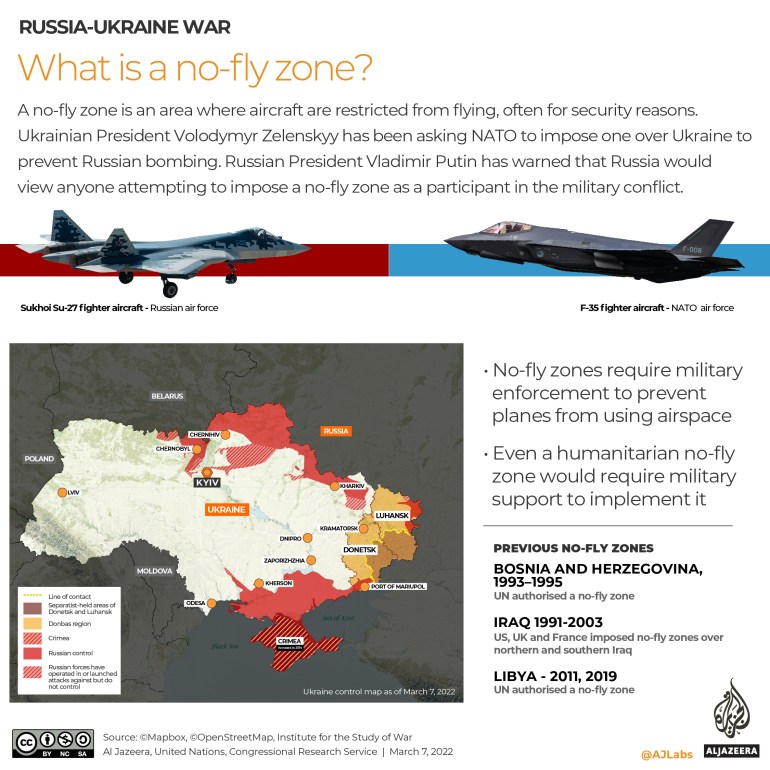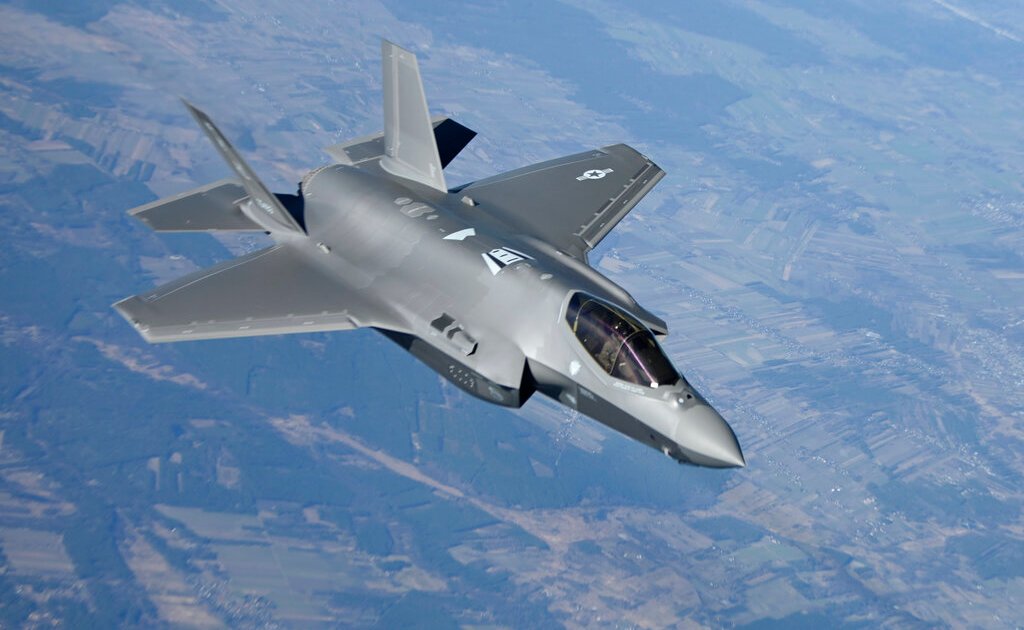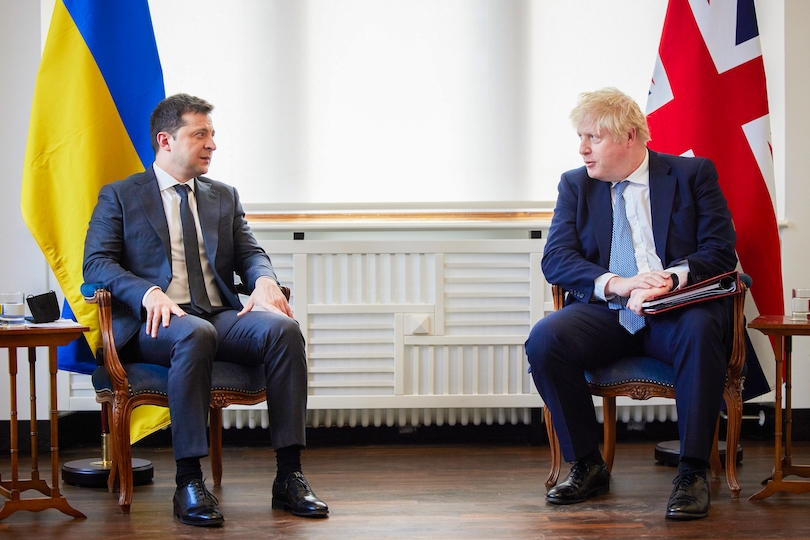[ad_1]
Washington, DC – A recent Reuters poll in the United States found that 74 percent of respondents support a NATO-imposed no-fly zone over Ukraine, as the American public has expressed growing solidarity with Ukrainians amid Russia’s invasion.
The Ukrainian government also has urged the US-led alliance to enforce a no-fly zone over the country, saying it is necessary to protect Ukrainian civilians under Russian shelling.
But as the war rages, prompting more than 1.7 million people to flee the country so far, the Biden administration has ruled out such a move, warning that it could spark a direct conflict with Russia – a nuclear-armed power.
Here, Al Jazeera looks at what a no-fly zone is and what imposing one over Ukraine would mean:
What is a no-fly zone?
Peter Harris, an associate professor of political science at Colorado State University, explained that a no-fly zone is a “designated geographical space where certain types of flights” are prohibited.
“In this instance, what people are really discussing is designated spaces inside Ukraine – perhaps the whole of Ukraine – prohibiting the use of military planes, specifically Russian military planes in that airspace,” Harris told Al Jazeera.
Harris said a no-fly zone would require destroying Russian air defences that could reach NATO jets in Ukraine and threatening to shoot down Russian planes over the country. “It would be a pretty dramatic escalation by NATO,” he said.
Who wants a no-fly zone?
The Ukrainian government has been the most vocal advocate for a no-fly zone over the country.
President Volodymyr Zelenskyy has repeatedly pleaded with NATO to bar Russian jets from flying in Ukraine’s airspace, a move he has said would save civilians from attacks. NATO has a treaty for the collective defence of all its members, but Ukraine is not a member of the alliance.
“We repeat every day: Close the sky over Ukraine. Close for all Russian missiles, for Russian combat aircraft, for all their terrorists,” Zelenskyy said on Sunday.
Why are nuclear weapons being mentioned?
Several officials and experts have stressed that Russia is a nuclear power when spelling out their opposition to a NATO-imposed no-fly zone over Ukraine.
Already, NATO’s military assistance to Ukraine risks an escalation, Harris said, and directly engaging in hostilities against Russia would bring Washington and its allies even closer to direct conflict with Moscow.
“If there was a hot conflict between Russia and a NATO member, then ultimately nuclear weapons are on the table,” Harris said. “Whether people like it or not, that’s always a possibility. And leaders cannot credibly promise that they will not escalate to the use of nuclear weapons because events can take on a life of their own and escape the control of those in charge.”
Where have no-fly zones been implemented in the past?
The US and NATO have led efforts to establish no-fly zones in three different conflicts over the past 30 years.
Iraq, 1992: Starting in 1992, after the first Gulf War, a US-led coalition enforced a no-fly zone over southern and northern Iraq in an effort to shield rebellious regions of the country from aerial attack by the government of then-President Saddam Hussein. That mechanism remained in place until the US invasion of Iraq in 2003.
Bosnia, 1993: NATO air forces collaboratively enforced a no-fly zone over the newly-established Republic of Bosnia and Herzegovina between 1993 and 1995 to protect the country from air attacks mainly by Bosnian-Serb forces. The UN Security Council had passed a resolution in 1993 authorising member-states to take “all necessary measures” to protect Bosnia’s airspace.
Libya 2011: After a popular uprising against longtime leader Muammar Gaddafi broke out in Libya, and the UN Security Council passed a resolution calling for flights over the country to be banned, NATO installed a no-fly zone amid fears of mass atrocities by the government. The NATO intervention soon morphed into an active effort to help Libyan rebels oust Gaddafi, who was captured and killed by armed opposition fighters months later.
But Harris stressed that Ukraine is a different case than the three previous cases because Russia is a nuclear-armed state with strong air forces and air defences. “It’s just a different ballgame,” he said.
Are there any other types of no-fly zones?
Some officials have called on the US to implement a “limited” no-fly zone to protect civilians in specific areas of Ukraine.
Dubbed a “humanitarian no-fly zone”, supporters of this measure say it would create safe havens for Ukrainians fleeing the war and launchpads for humanitarian relief efforts across the country without tilting the military balance of the conflict.
But it would still need to be enforced militarily and carries the same risks of miscalculation and escalation. “I don’t think there is a real distinction,” Harris said, adding that “humanitarian corridors” negotiated between Ukraine and Russia to allow civilians to flee the fighting are a different issue that would not require NATO intervention.
What has the Biden administration said?
Despite growing calls to enforce a no-fly zone over Ukraine, US President Joe Biden and his top aides have ruled out the idea. Here’s what they have said over the past week:
- White House Spokesperson Jen Psaki: “A no-fly zone requires implementation. It would require essentially the US military shooting down Russian planes and prompting a potential direct war with Russia – the exact step that we want to avoid.”
- Secretary of State Antony Blinken to NBC News: “The president … has a responsibility to not get us into a direct conflict, a direct war, with Russia – a nuclear power – and risk a war that expands even beyond Ukraine to Europe.”
- UN envoy Linda Thomas-Greenfield to ABC News: “President Biden has been very, very clear that American troops will not be put on the ground or in the air to escalate this war and make this an American war against the Russians.”
The U.S. is not setting up a no-fly zone in Ukraine. pic.twitter.com/aRlylXJboF
— John Kirby (@PentagonPresSec) March 1, 2022
What has NATO said?
NATO has echoed remarks from the US administration that enforcing a no-fly zone would put the military alliance in direct confrontation with Russia, explicitly rejecting Ukraine’s calls.
“We are not part of this conflict,” NATO Secretary-General Jens Stoltenberg said after a meeting of the transatlantic bloc last week. “We have a responsibility as NATO allies to prevent this war from escalating beyond Ukraine because that would be even more dangerous, more devastating and would cause even more human suffering.”
What has Russia said?
Russian President Vladimir Putin has warned the West against considering a no-fly zone over Ukraine, saying it would amount to participation in the war.
“Any movement in this direction will be considered by us as participation in an armed conflict by that country,” Putin said on Saturday.

What are US lawmakers saying?
With a few exceptions, there appears to be a consensus among American legislators that enforcing a no-fly zone over Ukraine is a bad idea. Hawkish Republican Senator Marco Rubio as well as more dovish lawmakers like Democratic Senator Chris Murphy have spoken out against the proposal.
“It’s a bad idea and Congress would never authorize it,” Murphy wrote on Twitter last week. “Military equipment for Ukraine, humanitarian support for Ukraine, crippling sanctions on Russia, movement of US troops to the eastern flank of NATO – these are all the right moves. But direct war between the world’s two nuclear powers should be a non-starter.”
For his part, Rubio said no-fly zone has become a “catchphrase” with many people failing to understand what it means. “It’s not some rule you pass that everybody has to oblige by. It’s the willingness to shoot down the aircraft of the Russian Federation, which is basically the beginning of World War III,” Rubio told ABC News on Sunday.
Still, a few legislators have expressed openness to the idea. Republican Congressman Adam Kinzinger made the case for a no-fly zone over Ukraine in a video message during the weekend, arguing that the US should not be deterred by Putin’s threats.
“I believe that failing to do so in fear of Putin simply empowers Putin even more. Now’s the time to put a stop to him and to his barbaric brutality,” he said.
[ad_2]
Source link
















